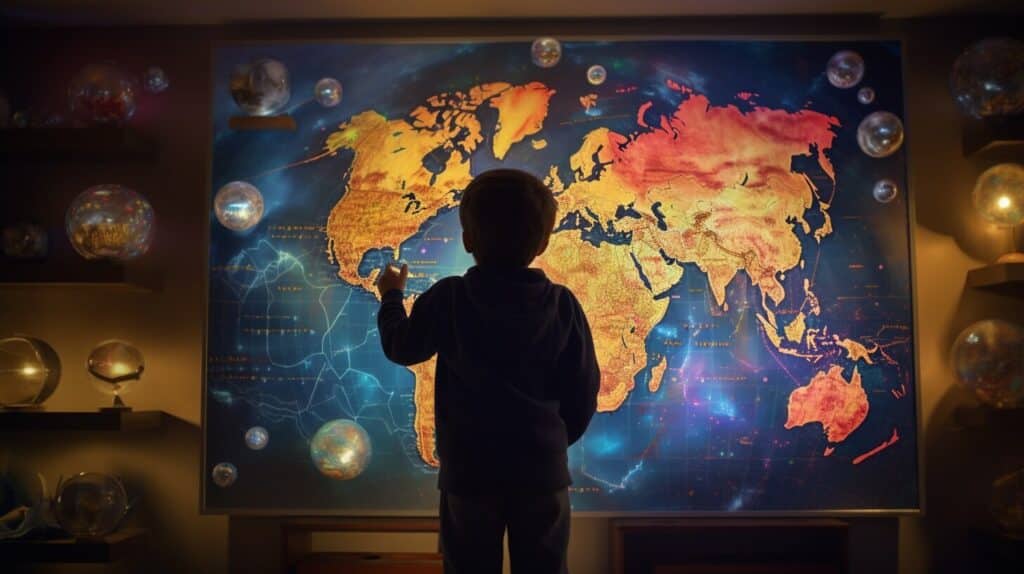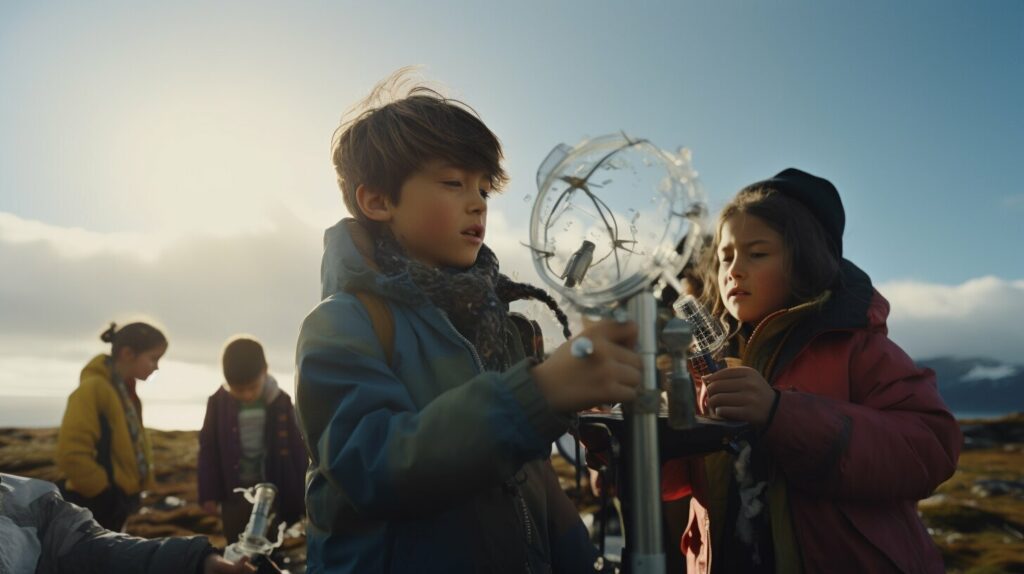Do you find yourself struggling to explain weather to your child? You’re not alone. Many parents and educators face the challenge of making weather concepts understandable and engaging for children. Fortunately, there are fun and easy techniques that you can use to help your child understand and appreciate the fascinating world of weather.
By teaching your child about weather, you can help them develop a deeper understanding of the world around them. Weather education also provides opportunities to learn about science, math, and geography in a way that is engaging and fun.
- Learn how to explain weather to a child in a way that is easy to understand
- Discover why weather education is important for kids
- Explore engaging activities to teach kids about weather
- Get fun weather facts for children
- Find out how weather affects our daily lives
Key Takeaways:
- Explaining weather concepts to children can be challenging but there are fun and easy techniques to make it understandable and engaging.
- Weather education can help children develop a deeper understanding of the world around them and provide opportunities for learning about science, math, and geography.
- Engaging activities, fun facts, and exploration of different types of weather can help children learn about weather in an enjoyable way.
Why is Weather Important for Kids to Understand?
Teaching your child about weather is more than just preparing them for a rainy day. Understanding weather is a crucial part of their overall education as it helps them understand the world around them and how it affects their daily lives.
Weather education for kids can also help develop their critical thinking skills as they learn to interpret weather maps and forecasts. It can also spark an interest in science and meteorology, leading to potential career paths in the future.
Furthermore, having a basic understanding of weather can help children appreciate the beauty of nature and the power of natural disasters. It can also teach them important safety measures, such as taking shelter during a thunderstorm or properly dressing for extreme temperatures.
Overall, weather education is an essential part of a child’s education, and by introducing them to the basics of weather, you can set them up for success and curiosity about the natural world.

Simple Weather Explanations for Kids: The Basics
Explaining weather to young children can be challenging, but breaking down the basics can make it easier for them to understand. Here are some simple explanations for the fundamental concepts of weather:
| Concept | Explanation |
|---|---|
| Temperature | Temperature is how hot or cold something is. When it’s hot outside, the temperature is high. When it’s cold outside, the temperature is low. |
| Precipitation | Precipitation is when water falls from the sky. This can be rain, snow, sleet, or hail. |
| Wind | Wind is moving air. When it’s windy outside, you can feel the air blowing. |
It’s important to note that these concepts can be interrelated. For example, when it’s cold outside, precipitation can fall as snow instead of rain, and wind can make it feel even colder.

Remember to use relatable examples when explaining weather to children. For instance, you could describe the feeling of wind as being like a fan blowing on your face. By making connections to their own experiences, children can better understand and remember the concepts of weather.
Engaging Activities to Teach Kids About Weather
If you want to make learning about weather fun for kids, try out these engaging and hands-on activities:
| Activity | Description |
|---|---|
| Make a weather journal | Have your child track the weather each day and record their observations in a journal. They can note the temperature, precipitation, and type of clouds. This will help them understand how weather changes over time. |
| Create a windsock | Using a paper bag or a piece of fabric, have your child decorate and construct a windsock. Hang it up outside and watch as it moves with the wind. This will help them visualize wind direction and speed. |
| Build a weather station | Gather materials such as a thermometer, barometer, and rain gauge. Help your child set up a weather station outside and teach them how to use each instrument to measure weather conditions. |
These activities are not only fun and interactive, but they also allow children to learn about weather in a practical way. They’ll be excited to see how the weather changes and eager to learn more!

Weather Facts for Children: Fun Trivia
Learning about weather can be fun! Did you know that the hottest temperature ever recorded on Earth was 134 degrees Fahrenheit in Death Valley, California? That’s hot enough to fry an egg on the sidewalk! Or how about this: lightning bolts can be hotter than the surface of the sun!
Here are some more fun weather facts that you can share with your child:
- The biggest snowflake ever recorded was 15 inches wide and 8 inches thick.
- A tornado can spin faster than a racecar drives.
- Humidity is the amount of water vapor in the air. When it’s really humid outside, it can feel like you’re swimming through the air!
- Thunder is the sound that lightning makes. It’s caused by the air around the lightning bolt heating up and expanding really quickly.
Did you know that weather can also have an impact on animals? Some birds can sense changes in air pressure and will fly to safety before a storm hits. And have you ever seen a dog or cat with puffy fur on a cold day? That’s their way of keeping warm!
Understanding weather can help us appreciate the world around us even more. Check out this cool image of a thunderstorm over the city! 
“Weather is a great metaphor for life – sometimes it’s good, sometimes it’s bad, and there’s nothing much you can do about it but carry an umbrella.” – Terri Guillemets
Exploring Different Types of Weather
Weather comes in many different forms, and each type can have a big impact on our daily lives. Understanding the different types of weather can help kids prepare for the day ahead and learn about the natural world around them. Here are some of the most common types of weather:
| Weather Type | Description |
|---|---|
| Sunny | Sunny weather is characterized by clear skies and no clouds, making it perfect for outdoor activities such as picnics or trips to the beach. Don’t forget to wear sunscreen! |
| Rainy | Rainy weather is characterized by precipitation in the form of rain. It’s important to wear rain boots and a raincoat to stay dry, and to avoid any outdoor activities that may not be safe in wet conditions. |
| Windy | Windy weather is characterized by strong gusts of wind that can make it difficult to walk or play outside. It’s important to hold onto hats and other loose objects that may blow away in the wind. |
| Snowy | Snowy weather is characterized by precipitation in the form of snow. This type of weather can be fun for building snowmen or going sledding, but it’s important to wear warm clothes and to be cautious when walking or driving on snow and ice. |

It’s important to remember that weather can change quickly and unexpectedly, so it’s always a good idea to check the forecast before heading out for the day. By understanding the different types of weather, kids can be prepared for anything Mother Nature may bring their way!
How Weather Affects Our Daily Lives
Weather has a significant impact on our daily lives, influencing numerous decisions we make every day. Understanding how it affects us can help us be better prepared and make smarter choices. Here are some ways in which weather affects our lives:
| Aspect | How Weather Affects It |
|---|---|
| Outdoor Activities | Weather affects our ability to enjoy outdoor activities such as picnics, hiking, and swimming. Rain, thunderstorms, and extreme temperatures can limit our ability to go outside. |
| Clothing Choices | We often choose what to wear based on the weather. Hot weather calls for light, breathable clothes, while cold weather requires layers and warm jackets. Being aware of the weather forecast can help us dress accordingly. |
| Health and Safety | Extreme weather conditions such as hurricanes, tornadoes, and heat waves can pose a threat to our health and safety. Knowing what kind of weather to expect can help us take necessary precautions to stay safe. |
| Transportation | Weather can significantly affect transportation, causing delays and cancellations. Snow and ice can make roads and sidewalks slippery, while heavy rain can flood them. Being prepared and informed can help us plan accordingly. |
As you can see, weather plays a crucial role in our day-to-day activities. By understanding its effects, we can make better decisions and stay safe and comfortable in any situation. Keep reading to learn more about how to explain weather to children.

Understanding Weather Forecasting
Weather forecasting is the process of predicting the weather for a particular area at a specific time. It helps us plan our day by knowing what type of weather to expect. But have you ever wondered how meteorologists are able to make these predictions?
Meteorologists use a variety of tools and techniques to study the weather. They look at current weather conditions, such as temperature, air pressure, and humidity, and compare them to past weather patterns. They also use satellite and radar technology to track storms and other weather events.
One of the most important tools that meteorologists use is a weather model. A weather model is a computer program that uses complex algorithms to simulate the behavior of the atmosphere. By inputting current weather data into the model, meteorologists can predict how the weather will change over time.
Reading a Weather Forecast
When you look at a weather forecast, you will see a variety of symbols and numbers. Here’s what they mean:
| Symbol | Meaning |
|---|---|
| Cloudy | |
| Rainy | |
| Sunny | |
| Partly cloudy |
The temperature is typically given in Fahrenheit or Celsius. The humidity is given as a percentage, and the air pressure is given in inches of mercury or millibars.
Remember that weather forecasts are not always 100% accurate. They are based on the best available data at the time, but unexpected changes in the weather can occur. It’s always a good idea to check the forecast regularly and be prepared for any possible weather conditions.
Understanding weather forecasting can help you plan your day and stay safe in different weather conditions. With these basic concepts, you can start interpreting weather forecasts and be prepared for whatever Mother Nature has in store.
Conclusion
Congratulations, you now have the tools to explain weather to a child in fun and easy ways! By teaching children about weather, you are helping them better understand the world around them and prepare for different weather conditions. Remember to make the learning experience engaging for your child by incorporating hands-on activities and fun trivia.
Encourage your child’s curiosity about the natural world and continue to explore different types of weather with them. By understanding how weather affects our daily lives, children will have a greater appreciation for their environment and be better equipped to make informed decisions about their activities and clothing choices.
Keep in mind that weather can be unpredictable, so it’s important to teach your child about weather forecasting and how to interpret weather symbols. With the knowledge and skills gained from this article, you can nurture your child’s natural curiosity and foster a lifelong love for learning about the world around them.
Can I Use the Same Fun and Easy Methods to Explain Science as I Do to Explain Weather to a Child?
Yes, you can certainly use fun ways to explain science to a child, just like you do when explaining the weather. Engaging experiments, colorful visuals, and amusing anecdotes can make even complex scientific concepts easy to understand. Building volcanoes, creating edible DNA models, or exploring the wonders of the natural world through interactive games are all fantastic approaches that make learning science entertaining and enjoyable for children.
What Are Some Fun and Easy Ways to Explain Labor Day to a Child?
Looking for fun and easy tips for explaining labor day to a child? Start by describing it as a special holiday dedicated to celebrating the hard work of workers in different fields. Share interesting stories about workers and their contributions, organize crafts related to careers, or even plan a mini parade honoring laborers.
FAQ
Q: How can I explain weather to a child in a fun and easy way?
A: Explaining weather to a child can be made fun and easy by using simple language and relatable examples. You can start by discussing basic concepts like temperature, precipitation, and wind. You can also engage them in hands-on activities, games, and creative projects to enhance their understanding of weather.
Q: Why is it important for kids to understand weather?
A: Teaching children about weather is important as it helps them understand the world around them. It enables them to make connections between weather and their daily lives, such as clothing choices, outdoor plans, and overall well-being. Weather education for kids also fosters their curiosity and encourages their interest in the natural world.
Q: What are some simple weather explanations for kids?
A: Simple weather explanations for kids can include discussing concepts like temperature (hot or cold), precipitation (rain, snow, etc.), and wind (gentle breeze or strong gusts). You can use relatable examples like dressing appropriately for the weather, observing rainbows after rain, or feeling the wind on a windy day.
Q: Can you suggest engaging activities to teach kids about weather?
A: Absolutely! Engaging activities to teach kids about weather can include hands-on experiments like making a homemade rain gauge or wind vane, playing weather-themed games like “Weather Bingo,” or creating artwork inspired by different weather conditions. These activities make learning about weather interactive and enjoyable for children.
Q: What are some interesting weather facts for children?
A: Weather facts for children can include information like how lightning is formed, how clouds are made, or fun trivia such as the highest recorded temperature or the average rainfall in different regions. Presenting these facts in an easy-to-understand manner can captivate children’s curiosity and expand their knowledge of the weather.
Q: How can I explain different types of weather to a child?
A: Explaining different types of weather to a child can involve describing and discussing sunny, rainy, windy, and snowy weather. You can provide simple explanations and use relatable examples like going to the beach on a sunny day, using an umbrella in the rain, or wearing warm clothes in snowy weather.
Q: How does weather affect our daily lives?
A: Weather affects our daily lives in many ways. It influences our clothing choices, outdoor plans, and activities. For example, we dress differently in hot and cold weather, plan outdoor activities based on the forecast, and adjust our routines according to weather conditions. Understanding the impact of weather helps children make informed decisions and adapt to their surroundings.
Q: Can you explain weather forecasting to young children?
A: Weather forecasting is the process of predicting weather patterns. It involves analyzing data, observing weather conditions, and using symbols to represent different weather elements. Young children can learn the basics of weather forecasting by understanding the symbols used in weather forecasts and the general meanings behind them.






